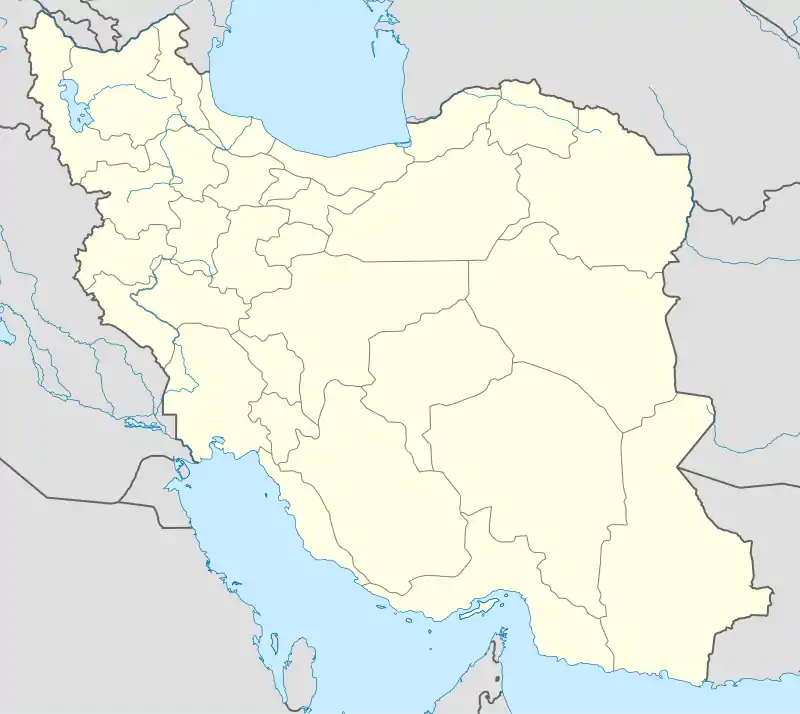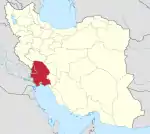Ramhormoz
Ramhormoz (Persian: رامهرمز; also Romanized as Rāmhormoz and Rām Hormuz; also known as (Rāmuz)[2] is the capital city of Ramhormoz County, Khuzestan Province, Iran. At the 2006 census, its population was 49,822, in 10,966 families.[3]
Ramhormoz
رامهرمز | |
|---|---|
City | |
 | |
 Ramhormoz | |
| Coordinates: 31°16′48″N 49°36′13″E | |
| Country | |
| Province | Khuzestan |
| County | Ramhormoz |
| Bakhsh | Central |
| Population (2016 Census) | |
| • Total | 74,285 [1] |
| Time zone | UTC+3:30 (IRST) |
| • Summer (DST) | UTC+4:30 (IRDT) |
In ancient times it had been known as Samangan, having been established by the Sassanid king Hormizd I,[4] although an Elamite tomb has been found as well. The historical territory of Ramshir is located in this area, only 3 kilometres (1.9 mi) away from the city.
According to a Sahih Bukhari hadith, Ramhormoz is the ancestral homeland of Salman the Persian.[5][6][7]
Today residents of the city are primarily Bakhtiari, Southern Lurs of the Bahma'i tribe, and native Khuzi Persians.
History
The proper history of the city begins in the Sassanid era, although there have been Elamite remains found in and around the city as well. The tomb of the Sassanid founder of the city, Hormizd I, is commonly thought to be situated within the city.
"With the gradual Muslim conquest of Khuzestan in the 7th century, Rāmhormoz was the scene of a peace agreement between the local Sasanian satrap, Hormozān, and the commander of the Muslim army.".[8] During the Islamic times, it was remarked by Muslim Geographers that the city contained a library comparable only to the one in Basra in the wealth of its collection, and that silk was produced in the city and distributed to distant lands.[9][10] The city enjoyed incredible opulence before entering a state of decline.
The 14th century Muslim Moroccan Berber traveler and explorer, Ibn Battuta, visited the city during his travels and described the city as "a fine city with fruit-trees and rivers." [11]
From late Safavid times until the Qajar era, the allegiance of the city frequently shifted between Khuzestan and Fars. In the 18th and 19th centuries, Lurs and Arabs started to settle within and around the city from nearby lands.[12]
Climate
Ramhormoz has a hot semi-arid climate (Köppen climate classification: BSh).
| Climate data for Ramhormoz (1987–2010) | |||||||||||||
|---|---|---|---|---|---|---|---|---|---|---|---|---|---|
| Month | Jan | Feb | Mar | Apr | May | Jun | Jul | Aug | Sep | Oct | Nov | Dec | Year |
| Record high °C (°F) | 27.2 (81.0) |
31.0 (87.8) |
37.4 (99.3) |
43.2 (109.8) |
47.8 (118.0) |
50.6 (123.1) |
51.6 (124.9) |
51.4 (124.5) |
48.6 (119.5) |
43.0 (109.4) |
35.8 (96.4) |
31.0 (87.8) |
51.6 (124.9) |
| Average high °C (°F) | 17.1 (62.8) |
20.2 (68.4) |
25.2 (77.4) |
32.1 (89.8) |
39.7 (103.5) |
44.5 (112.1) |
46.0 (114.8) |
45.8 (114.4) |
42.0 (107.6) |
35.9 (96.6) |
26.7 (80.1) |
19.8 (67.6) |
32.9 (91.2) |
| Daily mean °C (°F) | 12.7 (54.9) |
15.0 (59.0) |
19.2 (66.6) |
25.4 (77.7) |
32.2 (90.0) |
36.3 (97.3) |
38.2 (100.8) |
38.0 (100.4) |
34.2 (93.6) |
28.9 (84.0) |
20.7 (69.3) |
15.0 (59.0) |
26.3 (79.3) |
| Average low °C (°F) | 9.3 (48.7) |
9.8 (49.6) |
13.3 (55.9) |
18.7 (65.7) |
24.7 (76.5) |
28.2 (82.8) |
30.5 (86.9) |
30.1 (86.2) |
26.3 (79.3) |
21.8 (71.2) |
14.7 (58.5) |
10.2 (50.4) |
19.7 (67.5) |
| Record low °C (°F) | −0.8 (30.6) |
−0.8 (30.6) |
2.8 (37.0) |
7.6 (45.7) |
15.6 (60.1) |
21.6 (70.9) |
23.4 (74.1) |
22.6 (72.7) |
18.4 (65.1) |
12.4 (54.3) |
2.2 (36.0) |
0.6 (33.1) |
−0.8 (30.6) |
| Average precipitation mm (inches) | 77.1 (3.04) |
42.5 (1.67) |
43.2 (1.70) |
19.7 (0.78) |
1.9 (0.07) |
0.1 (0.00) |
0.1 (0.00) |
0.2 (0.01) |
0.9 (0.04) |
8.0 (0.31) |
29.0 (1.14) |
87.5 (3.44) |
310.2 (12.21) |
| Average precipitation days (≥ 1.0 mm) | 7.0 | 4.4 | 4.3 | 3.2 | 0.5 | 0.0 | 0.0 | 0.1 | 0.1 | 0.8 | 3.4 | 5.7 | 29.5 |
| Average relative humidity (%) | 69 | 58 | 48 | 37 | 21 | 17 | 19 | 21 | 21 | 28 | 45 | 65 | 37 |
| Mean monthly sunshine hours | 175.5 | 195.1 | 229.8 | 233.4 | 290.6 | 339.6 | 336.1 | 339.8 | 309.8 | 272.3 | 214.7 | 178.3 | 3,115 |
| Source: Iran Meteorological Organization (records),[13] (temperatures),[14] (precipitation),[15] (humidity),[16] (days with precipitation),[17]
(sunshine)[18] | |||||||||||||
See also
- Abū Muḥammad al-Ḥasan ibn ʻAbd al-Raḥmān ibn Khallād al-Rāmahurmuzī—an early Islamic scholar and hadith specialist
References
- https://www.amar.org.ir/english
- Ramhormoz can be found at GEOnet Names Server, at this link, by opening the Advanced Search box, entering "-3080776" in the "Unique Feature Id" form, and clicking on "Search Database".
- "Census of the Islamic Republic of Iran, 1385 (2006)". Islamic Republic of Iran. Archived from the original (Excel) on 2011-11-11.
- The History of Al-Tabari: The Sasanids, the Lakhmids, and Yemen. SUNY Press. 1999. p. 43. ISBN 9780791443569.
- Milad Milani (2014). Sufism in the Secret History of Persia. Routledge. p. 180. ISBN 9781317544593.
In one particular hadith, Salman mentions he is from Ramhormoz, though this is a reference to his ancestry as his father was transferred from Ramhormoz to Esfahan, residing in Jey (just outside the military camp), which was designed to accommodate the domestic requirements of military personnel.
- Sameh Strauch (Translator) (2006). Mukhtaṣar Sīrat Al-Rasūl. Darussalam. p. 94. ISBN 9789960980324.
- Sahih Bukhari, Book 5, Volume 58, Hadith 283 (Merits of the Helpers in Madinah [Ansaar]).
Narrated Salman: I am from Ram-Hurmuz (i.e. a Persian town).
- Chase F. Robinson, “The Conquest of Khūzistān,” BSOAS 67/1, 2004, pp. 14-39.
- Wilhelm Barthold, An Historical Geography of Iran, Princeton, N.J, 1984.
- اصطخری, ابواسحاق ابراهیم، به اهتمام ایرج افشار (1368). مسالک و ممالک. تهران: علمی و فرهنگی.
- The Travels of Ibn Battuta A. D. 1325-1354. Volume II. pp. 283. The Hakluyt Society/Cambridge University Press; First Thus Edition (January 1, 1962)
- https://iranicaonline.org/articles/ramhormoz
-
- "Highest record temperature in Ramhormoz by Month 1987–2010". Iran Meteorological Organization. Retrieved April 8, 2015.
- "Lowest record temperature in Ramhormoz by Month 1987–2010". Iran Meteorological Organization. Retrieved April 8, 2015.
-
- "Average Maximum temperature in Ramhormoz by Month 1987–2010". Iran Meteorological Organization. Retrieved April 8, 2015.
- "Average Mean Daily temperature in Ramhormoz by Month 1987–2010". Iran Meteorological Organization. Retrieved April 8, 2015.
- "Average Minimum temperature in Ramhormoz by Month 1987–2010". Iran Meteorological Organization. Retrieved April 8, 2015.
- "Monthly Total Precipitation in Ramhormoz by Month 1987–2010". Iran Meteorological Organization. Retrieved April 8, 2015.
- "Average relative humidity in Ramhormoz by Month 1987–2010". Iran Meteorological Organization. Retrieved April 8, 2015.
- "No. Of days with precipitation equal to or greater than 1 mm in Ramhormoz by Month 1987–2010". Iran Meteorological Organization. Retrieved April 8, 2015.
- "Monthly total sunshine hours in Ramhormoz by Month 1987–2010". Iran Meteorological Organization. Retrieved April 8, 2015.
| Wikimedia Commons has media related to Ramhormoz. |
